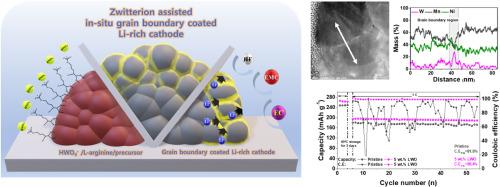Zwitterion assisted in-situ grain boundary coating on Li-rich cathode boosting electrochemical performance in Li-ion batteries
IF 12.7
1区 材料科学
Q1 ENGINEERING, MULTIDISCIPLINARY
引用次数: 0
Abstract
High-capacity and high-voltage Li-rich cathode materials are promising candidates for next-generation LIB cathodes due to their high energy density characteristics. However, they face challenges such as electrolyte side reactions at high voltages and slow kinetic properties. To overcome these challenges, this study proposed a one-pot Li2WO4 (LWO) grain boundary coating method. Additionally, a novel synthesis process utilizing zwitterions was introduced to uniformly position heavy tungsten on the surface of a cathode material. Through grain boundary coating, the cathode material was modified not only at the secondary particle level, but also between primary particles by filling grain boundaries with the coating compound. The synthesized LWO grain boundary coated Li-rich cathode exhibited significantly superior rate capability and cycle stability compared to the pristine material. Furthermore, it demonstrated a more stable cycling behavior after high-temperature storage than pristine counterpart. This study presents a primary particle surface modification technique through grain boundary coating and a one-pot synthesis process leveraging zwitterions as a new driving force, providing a new perspective for enhancing the performance of Li-rich cathode materials.

富锂离子阴极上的原位晶界镀膜由齐聚物辅助,可提高锂离子电池的电化学性能
高容量和高电压富锂阴极材料因其高能量密度特性而有望成为下一代锂离子电池阴极的候选材料。然而,它们面临着高电压下电解质副反应和缓慢的动力学特性等挑战。为了克服这些挑战,本研究提出了一种一锅法 Li2WO4(LWO)晶界镀膜方法。此外,还引入了一种利用齐聚物的新型合成工艺,以在阴极材料表面均匀地定位重钨。通过晶界镀膜,阴极材料不仅在次生颗粒层面得到了改性,而且通过用镀膜化合物填充晶界,在主生颗粒之间也得到了改性。与原始材料相比,合成的 LWO 晶界涂层富锂阴极在速率能力和循环稳定性方面有明显优势。此外,与原始材料相比,它在高温储存后的循环行为也更加稳定。本研究提出了一种通过晶界镀膜进行初级粒子表面改性的技术,以及一种利用齐聚物作为新驱动力的一锅合成工艺,为提高富锂阴极材料的性能提供了一个新的视角。
本文章由计算机程序翻译,如有差异,请以英文原文为准。
求助全文
约1分钟内获得全文
求助全文
来源期刊

Composites Part B: Engineering
工程技术-材料科学:复合
CiteScore
24.40
自引率
11.50%
发文量
784
审稿时长
21 days
期刊介绍:
Composites Part B: Engineering is a journal that publishes impactful research of high quality on composite materials. This research is supported by fundamental mechanics and materials science and engineering approaches. The targeted research can cover a wide range of length scales, ranging from nano to micro and meso, and even to the full product and structure level. The journal specifically focuses on engineering applications that involve high performance composites. These applications can range from low volume and high cost to high volume and low cost composite development.
The main goal of the journal is to provide a platform for the prompt publication of original and high quality research. The emphasis is on design, development, modeling, validation, and manufacturing of engineering details and concepts. The journal welcomes both basic research papers and proposals for review articles. Authors are encouraged to address challenges across various application areas. These areas include, but are not limited to, aerospace, automotive, and other surface transportation. The journal also covers energy-related applications, with a focus on renewable energy. Other application areas include infrastructure, off-shore and maritime projects, health care technology, and recreational products.
 求助内容:
求助内容: 应助结果提醒方式:
应助结果提醒方式:


